ABOUT THE CLIENT
Northwards Housing is the housing arm of Manchester City Council and manages approximately 12,500 homes in north Manchester. With ambitious targets to be Net Zero by 2038, Northwards Housing has completed several projects to improve the energy efficiency of their stock. The result, a 48% reduction in CO2 achieved over the last 15 years.
ABOUT US
Switchee exists to improve the quality of life for people living in rented homes. We help landlords like Northwards fulfil their aim of solving the housing crisis by providing self-managing and high-quality homes. Since our founding in 2015, we have dedicated ourselves to developing the technology that will enable Social Landlords and residents to innovate and save. Our team are committed to solving real problems for real people, like fuel poverty, condensation, damp and mould, overheating and heating system failures. Switchee combines social purpose, intelligent analytics and smart in-home technology to create services which enable residents and landlords to do more with less. We earn a place in people’s homes by making their lives more comfortable and saving them money, and we earn our place in society by addressing the climate emergency.
THE PROJECT
One such project, the Homes as Energy Systems (HAES) is a £13.8m project, with £6.9m part funded by the European Regional Development Funds through the 2014-2020 England Operational Programme
HAES is delivering an estimated 1,000 retrofit interventions with the aim to increase the energy efficiency in the housing sector and decrease the annual emissions of Green House Gases (GHG) by 2,750 tonnes of CO2e in the Greater Manchester region1. All interventions have been identified and comprise of a set of capital works that include ground source heat pumps, air source heat pumps, photovoltaic systems, batteries, external wall insulation and deep energy demand reduction retrofit. Northwards Housing included 540 properties where either the inefficient communal gas boiler or individual gas boiler was replaced with renewable heating. Of which, 55 also benefited from Switchee smart heating controls where Ground Source Heat Pumps were installed.
THE CHALLENGE
Northwards Housing has the same challenge as many other providers, to upgrade and deliver energy efficiency solutions within a constrained budget. Following the implementation of Net Zero 2038 targets, there is now even a greater need to deploy retrofit measures at scale and speed. Deployment of the improvements is just one part of the solution. To realise the full potential of the energy efficiency measures, resident education and adoption of the new technology is key – yet can be a challenge in its own right.
Delivering the project during the COVID-19 pandemic brought additional challenges in providing onsite and in person support to help with the residents’ transition and adoption of the new system.
COST OF HEATING
The existing communal heating replacement, with modern efficient heat pumps, resulted in residents moving away from paying for their heating through a service charge as part of their weekly rent to an individual cost on their electricity bills. This provided a challenge for most residents, as it was something they’d never had to manage before.
ADOPTION OF RENEWABLE HEATING SYSTEMS
The project involved significant resident engagement to help residents adapt and adopt renewable heating systems using the heat pumps. Previously, the communal heating system had no programmable heating controls, residents only had a choice of having their heating on or off and relied on the thermostatic radiator valves to manage their room temperature. As a result, residents had an embedded habit of opening windows to control their desired comfort levels which is not good from an emissions perspective. Reliance on them using a thermostatic control without any additional support was not practical. A method was needed to identify those households who would require support and education to adapt to the new system. Having visibility of their energy use on electricity bills, at first, generated a lot of queries from residents with concerns over the increased costs. To overcome this, Northwards provided additional support and advice, to explain how best to both use their new heating system and the associated costs. This was done with direct contact with their energy adviser, by telephone and (when restrictions were lifted) in person visits. A frequently asked questions document was produced and issued to residents to assist with a further understanding of the new system. A commissioning checklist was also produced to ensure that, at handover via the contractor, the residents understood the system better. This was tied in with easy user guides from the suppliers.
THE SOLUTION
By using Internet of Things (IoT) technology, Northwards have access to real-time data insights and tangible evidence on running costs, temperature and usage, empowering them to give support and engage residents. Switchee’s were installed as the main heating control in 55 homes (1 bed flats), providing residents with an easy-to-use Smart Thermostat without the need for them to have their own internet or Wi-Fi connection. With inbuilt sensors, Switchee understands occupancy and optimises heating settings, saving residents up to 17% on their energy bills2. Real time data is transferred via the GSM network to produce a dedicated dashboard for Northwards. The project was delivered during the COVID-19 pandemic which brought additional challenges to provide onsite and in person support. During the period when residents were adapting to their new system, as Switchee can remotely connect to the devices we were able to provide this remote support. This was a key success during the pandemic, as it meant that visits to help amend timers and profiles for residents wasn’t needed – providing remote assistance and having a hidden saving cost of an in person visit. The Switchee Portal provides a range of welfare and maintenance KPIs, including risk of fuel poverty, damp and mould, and risk of heat stroke. Northwards have been empowered to proactively monitor the performance of the heating system and identify those most at risk or who would need additional support. Furthermore, having a visual method to understand and use in helping both education and queries for residents and using the insights to show where further efficiencies can be achieved.
FINDINGS ON BEHAVIOUR V CO2 USAGE
Whilst the initial project was delivered and completed during December 2020 – July 2021, the ongoing insight through the devices has provided Northwards with evidence of how significant the use of different heating systems and controls affects CO2 emissions and energy consumption. Having real time data to evidence and validate the cost of energy usage of a heat pump system, combined with the ability to compare against the previous service charge cost (circa £8 p/w) has been one of the key outcomes for Northwards. The information provided in the graphs and tables below compares two neighbouring properties (within the same 4 block, low rise block) in terms of comfort and energy use. Using the Switchee data, Property ‘A’ uses the system ‘as instructed’ in terms of leaving the temperature at a set level and helping the heat pump manage itself as efficiently as possible. Property ‘B’ turns the settings up and down (despite much advice and guidance to the contrary) leading to a more inefficient way of operating the heat pump. The graph below provides the actual usage, over a 12-month period, showing the target temperature set at a constant 21’ degrees for Property ‘A’. The resident has left the heating on, since installation, on 21 degrees – in the few initial days directly after install the setting was higher until the resident found their comfortable setting at 21 degrees. The room temperature closely mirrors the target temperature in the graph although understandably goes over this in the summer months – this means the heating will not come on at all during these times and save the resident money versus the previous service charge (approx. £8/week).
Property ‘A’ 12-month property data set.
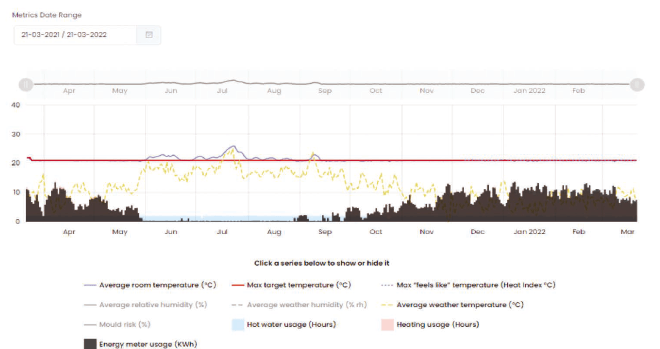
The next Figure, provides the actual usage for Property B, over a 5-month period inclusive of the colder months. This does not have a full 12-month data set, as per property ‘A’, as the installation was completed at a later programme date. The target temperature settings are consistently altered by the resident despite advice to the contrary. The resident has higher bills as a result (see Figure 3) during this period and has also raised issues about comfort levels.

Property ‘B’ data set. Note this is not over 12 months due to installation being undertaken later in programme than Property ‘A’.
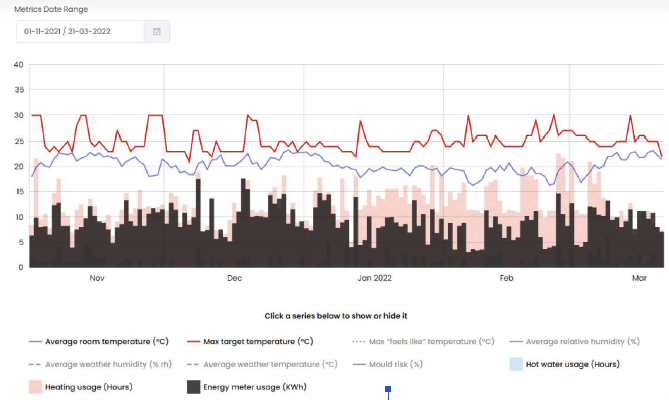
By comparing the usage patterns of desired temperature, kWh of the heat pump and the actual temperature over a number of homes3, Northwards have been able to establish the following:
Homes where heating is at a set temperature consume, on average, 1.2 kWh less electricity per day4, equivalent to circa 0.25kg less CO2. In addition, properties maintain a 1.5’c higher temperature than those where residents select inconstant and intermittent heating preferences.
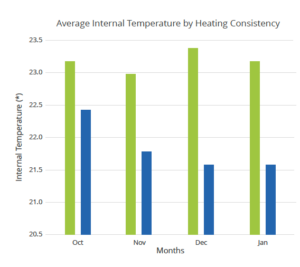
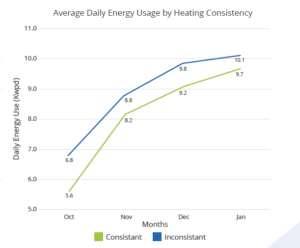
In summary on properties ‘A’ and ‘B’ the following was identified:
- – Property ‘A’ had set their temperature set at a constant 21 degrees.
- – Property ‘B’ used their heating system ad-hoc.
- – Property ‘A’ used 60KwH less than Property B during the same (winter) time period5
- – Property ‘A’ achieved a higher average temperature than property B and higher comfort levels.
The table shows the actual KwH usage by month6. (Data for property B only available from November, as heating and data wasn’t upgraded until November 2021).
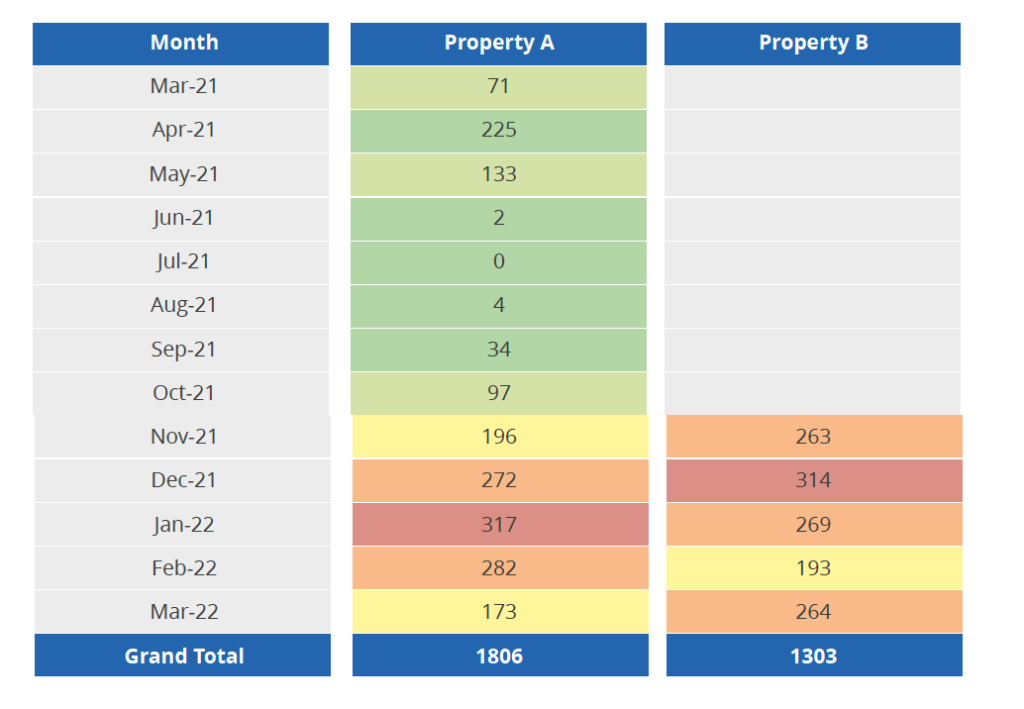
Furthermore, the ability to understand the KWh usage over a full year (March 2021-2022), when leaving the desired target temperature at a constant 21’, shows that the overall average weekly KWh usage equates to £5.20 per week cost, providing a resident saving circa £2.70 per week, when compared to the Service Charge Cost7.
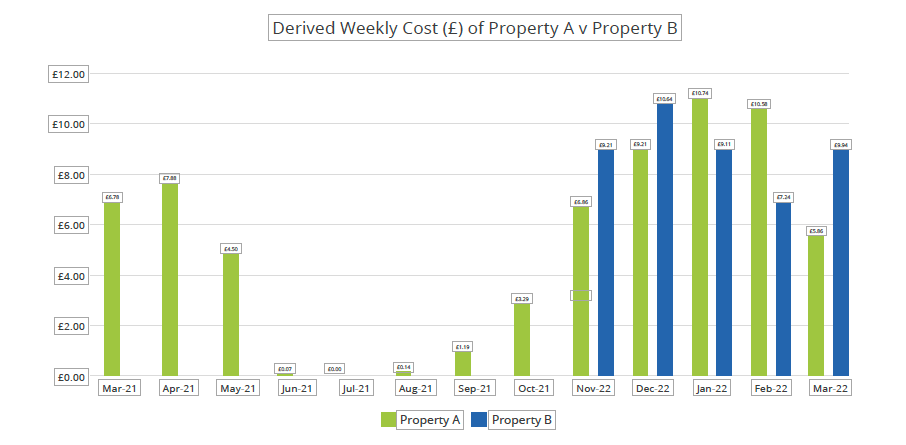
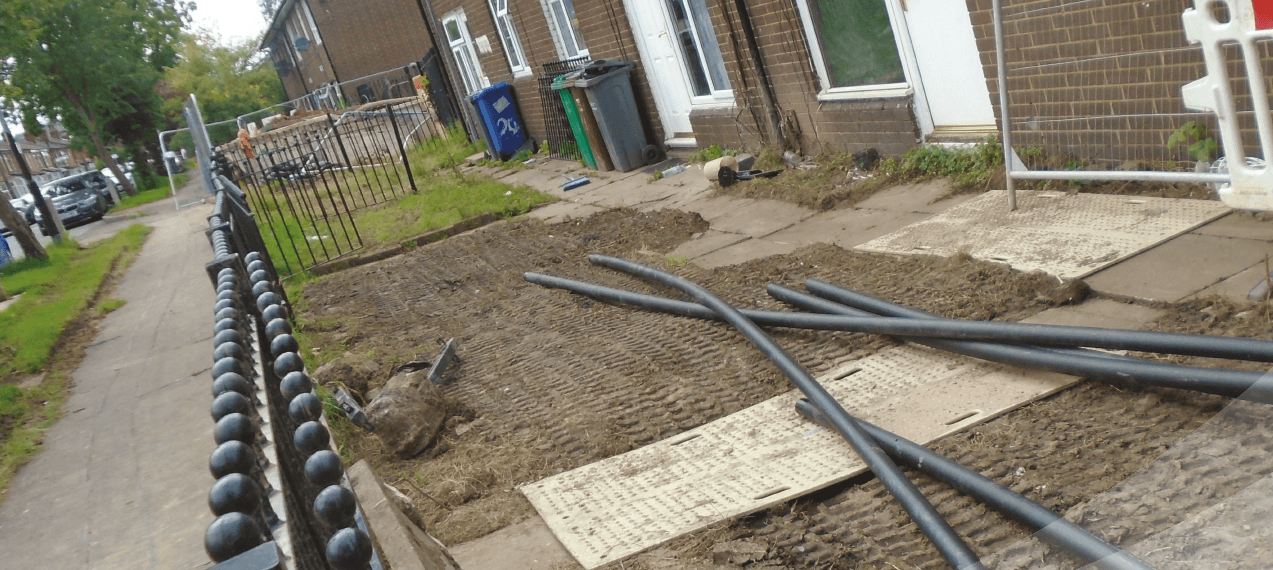
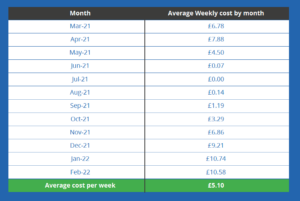
34% energy price saving
(against 52 weeks x £8 service charge equating to £416 per year).
The overall findings are that the best performing homes are those which leave the heating system alone, and benefit from lower running costs, regardless of the heat loss perimeter and higher heat loss figures. This, combined with the above evidence, that even with a higher heat loss value, those who kept their heating on a constant temperature were still able to heat their home more efficiently, producing less CO2 than the archetypes with a higher heat loss value. Retrofitting and insulation of homes, coupled with the adoption of renewable heating systems and installation of IoT technology will most certainly provide the route to help Northwards achieve zero carbon by 2038. If every one of their tenants were able to set their heating at a set temperature, then collectively over a full year this would equate to an additional saving of 1,140 tonnes of CO2 in addition to the measures installed.
THE RESULTS
Having visibility of property performance, Northwards can now efficiently respond to enquiries and proactively identify households who require additional support, including risk indicators for fuel poverty, damp & mould. The ERDF HAES project is a great example of how operations can be transformed from reactive maintenance to proactive Asset Management. Through combining the latest technology and ensuring residents’ engagement and adoption, this is a fantastic example of how Housing Providers can reduce tenants’ energy bills, better maintain housing stock while driving towards challenging Net Zero targets.
CLICK HERE TO DOWNLOAD THE FULL CASE STUDY.
Get in touch